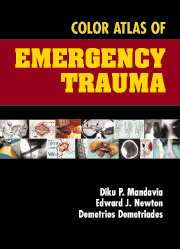4 - THORACIC INJURY
Published online by Cambridge University Press: 10 November 2010
Summary
Introduction
Chest trauma is estimated to be the primary cause of death in 25% of traumatic mortalities and a contributing factor in another 25% of deaths. Good understanding of the pathophysiology of chest trauma and timely selection of the appropriate investigations and treatment are all critical components for optimal outcome.
Clinical Examination
Advanced trauma life support (ATLS) principles are particularly important in the initial evaluation and management of the chest trauma patient.
During the primary survey, there are six lifethreatening conditions that need to be identified and treated:
Airway obstruction
Tension pneumothorax
Open pneumothorax with a “sucking wound”
Flail chest
Massive hemothorax
Cardiac tamponade
During the secondary survey, there are another six potentially lethal chest injuries that should be identified and treated. The diagnosis of these conditions may need more complex and time-consuming investigations.
Lung contusion
Myocardial contusion
Aortic rupture
Diaphragmatic rupture
Tracheobronchial rupture
Esophageal injury
Investigations
History and clinical examination will determine the type and timing of investigations necessary for the safe and efficient evaluation of the chest trauma patient. Very often, in unstable patients, therapeutic interventions such as thoracostomy tube insertion or thoracotomy may be initiated without any investigations.
- Type
- Chapter
- Information
- Color Atlas of Emergency Trauma , pp. 83 - 128Publisher: Cambridge University PressPrint publication year: 2003



